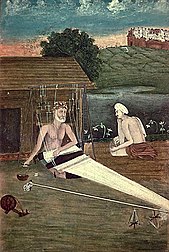Sant Kabir
Kabir's influence extended beyond his own lifetime. His teachings inspired the formation of the Kabir Panth, a community of followers who sought to live by his spiritual principles. The Kabir Panth continues to exist to this day, with followers spread across India and other parts of the world.
SANT


When consciousness in meditation reaches the thousand-petalled lotus, it then rises to the eighth lotus above. This is called Unmani Chakra. In this state the devotee sees the Divine Light without the presence of a lamp, and hears the Divine Melody without musical instruments.
The Life and Teachings of Sant Kabir Das: A Spiritual Luminary
Introduction:
Sant Kabir Das, also known as Saint Kabir, was a prominent figure in Indian spiritual history. He was a mystic poet, philosopher, and saint who lived in the 15th century. Kabir's teachings and poetry transcended religious boundaries and had a profound impact on both Hinduism and Islam. His compositions, filled with spiritual depth and social commentary, continue to inspire people of various faiths even today. This article delves into the life, philosophy, and enduring legacy of Sant Kabir Das.
Early Life and Background:
The exact details of Kabir's birth and parentage remain shrouded in mystery, adding to the enigmatic nature of his life. According to popular belief, he was born in 1398 CE in the city of Varanasi, India. It is said that Kabir was born to a Muslim family but was later adopted and raised by a Hindu weaver couple named Niru and Nima.
Teachings and Philosophy:
Kabir's teachings were characterized by a unique synthesis of Hindu and Islamic elements. He emphasized the importance of spirituality over external religious rituals and rituals, advocating for a direct and personal experience of the divine. Kabir rejected the notion of caste and criticized religious dogmas, promoting a universal message of love, unity, and brotherhood.
His compositions, known as "dohas" or couplets, were composed in vernacular Hindi and infused with metaphorical and allegorical imagery. Kabir used simple language and everyday examples to convey profound spiritual truths. His dohas were often sung as bhajans (devotional songs) and continue to be an integral part of Indian folk and devotional music.
Social and Spiritual Legacy:
Sant Kabir Das challenged prevailing social and religious norms during his time. His teachings emphasized equality, inner reflection, and ethical conduct. Kabir spoke out against social divisions, particularly caste discrimination and religious hypocrisy. He believed that all human beings were equal in the eyes of God and that spiritual realization was attainable by anyone, irrespective of their social or religious background.
Kabir's influence extended beyond his own lifetime. His teachings inspired the formation of the Kabir Panth, a community of followers who sought to live by his spiritual principles. The Kabir Panth continues to exist to this day, with followers spread across India and other parts of the world.
Conclusion:
Sant Kabir Das, the revered saint and poet, left an indelible mark on the spiritual and cultural fabric of India. His timeless teachings, delivered through his eloquent dohas, continue to resonate with people seeking spiritual solace and enlightenment. Kabir's legacy transcends religious boundaries, reminding us of the universal truths of love, unity, and the pursuit of inner awakening. In a world often divided by differences, the teachings of Sant Kabir Das serve as a guiding light, inspiring individuals to embrace harmony, compassion, and a deeper connection with the divine.
